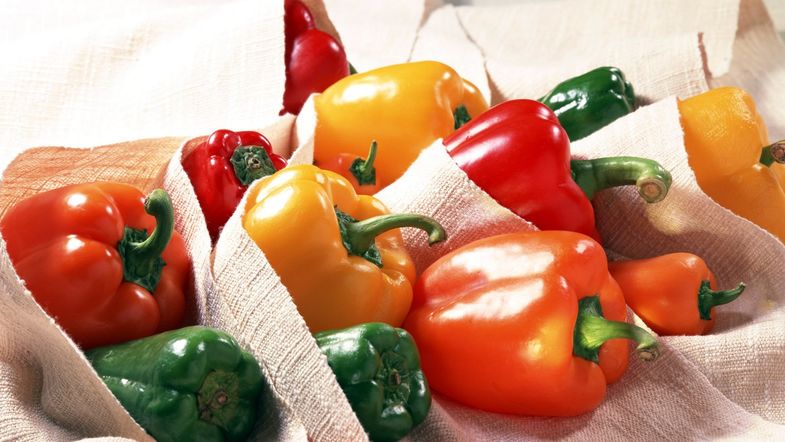
Everyone knows the harsh climate of Siberia and how it can adversely affect heat-loving crops. Therefore, a large number of breeders are working on breeding more resistant varieties of sweet pepper. At present, many species have already been bred that with good and uncomplicated care can give a positive result. Basically, these are early and mid-early cultures. Late ripeners do not have time to ripen.
Content
Hybrids for Siberia
Despite the abundance of choice, hybrids are popular in country circles. Because of the maximum adaptation to the characteristic features of the climate, they have shown themselves worthily, and occupy their honorable places in the beds of garden plots of gardeners - Siberians.
White lady
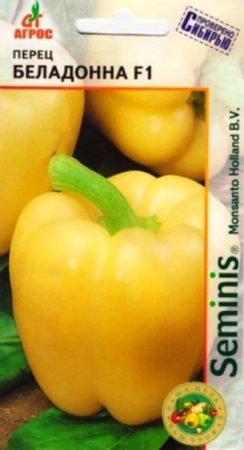
Early hybrid. Bushes are compact. Large-fruited - fruits in the form of a cube. Fruits 10 - 11 cm long, wall 6 - 7 mm. Color from white to orange.
Claudio
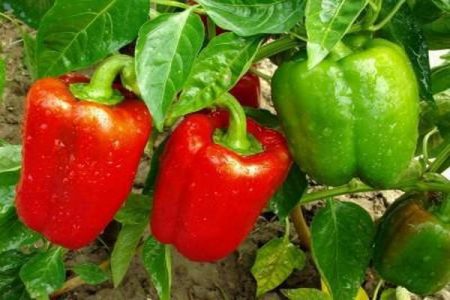
Early - 75 - 85 days, the growing season lasts. Ripe fruits have the shape of an elongated cube, divided into 4 chambers and painted in bright red color. Sweet, with a slight bitterness. Weigh 200-300 g each. Juicy, wall thickness - 1 - 1.1 cm. Bushes are leafy, tall, up to 1 m. Each bush produces up to 10 fruits. Resistant to burns, diseases. Transportable.
Gemini
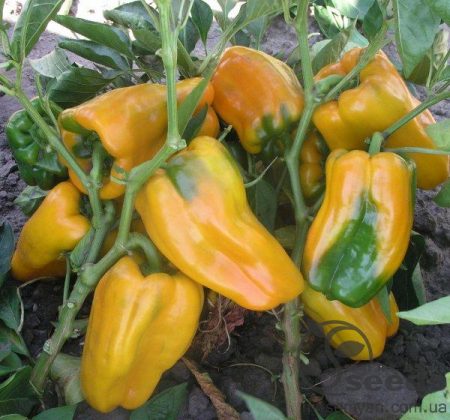
The growing season is 75 - 85 days. Leafy bushes, medium-sized about 60 cm. Fruits are large and elongated up to 15 cm, in the form of a cube, having 4 chambers. On the bush forms 6 to 10 peppers. The walls are about 0.8 cm thick. They are yellow in color. Weigh 200-300 g. Resistant to abundant sunlight and viruses. You need to tie the branches, otherwise they can break under the weight of the fruits.
Montero
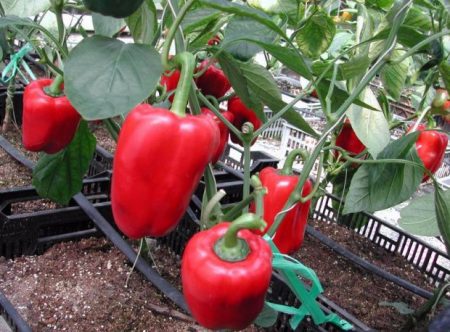
From seedlings to ripeness 110 - 115 days. Bushes grow to 1 - 1, 3 m. The fruits are painted red, with a glossy tint, have a prismatic shape. The weight of a mature fetus is up to 300 g. Walls up to 0.8 cm thick. Unpretentious. Stable yield of 14 kg per 1 square. m
The best varieties of pepper for Siberia
These 2 famous varieties are the standards of Siberia.
Topolin
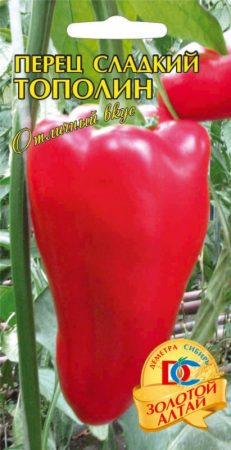
It reaches full ripening in 120 - 135 days. The fruits are conical in shape with a blunt tip, without a groove in the peduncle. The walls of large and fleshy fruits of about 0.7 cm are red in color. Bushes "Topolina" grow up to 65 cm. Up to 10 - 14 fruits can ripen on one bush. It has a high, stable yield: up to 4.5 kg per 1 sq. Km. m. Unpretentious in the care and attacks of the pest. It has a universal purpose.
Gingerbread man
Bred breeders from Moldova. Already 40 - 50 years in active use. An early variety that can stably bear fruit in various conditions: in open beds or under shelter. Undersized - up to 50 cm. Leafy. Fruits are red with the presence of 3 to 4 chambers, with a wall thickness of 0, 9 - 1, 2 cm. One ripe fruit usually weighs about 85 - 150 g, rounded. Universal to use. Productivity from 1 sq. m to 6, 5 kg.
Early grades for Siberia
For many years, Siberians have successfully grown bell pepper. And they give their preference to the early species.
Novosibirsk
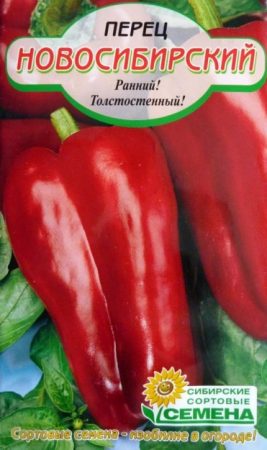
He owes his creation to the Siberian Botanical Garden. Early ripening. From seed to fully grown seedlings - no more than 2 months. After 90 - 95 days, the first pods ripen. For 1 square. m produces up to 4, 5 - 5, 5 kg. The fruit weighs about 60 g, with a wall thickness of up to 0.7 cm, painted red in the shape of a prism. It smells good, tastes without bitterness. The bush is compact. He does not like transplants - for a while he stops in growth. Resistant to disease.
Early miracle
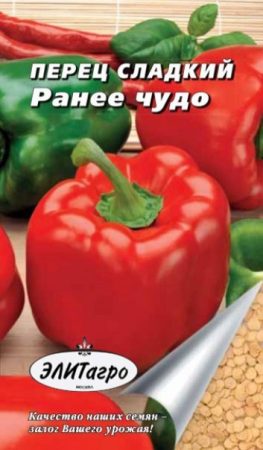
Ripe, red colored peppers can be obtained after 95 - 120 days as seedlings sprout.The fruits are dense, cone-shaped with a wall thickness of 0, 6 - 0.7 cm. Universal purpose. Transportable. Productivity - 10 - 12 kg per 1 sq. Km. m. The bush grows a little more than 1 m, so it needs to be tied up. Resistant to viruses and stress.
Merchant
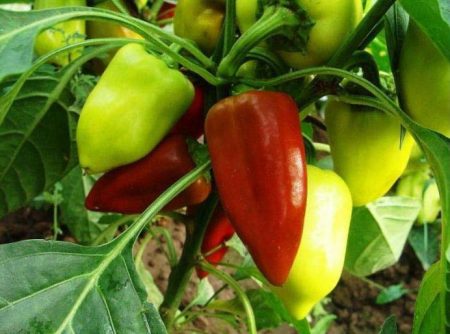
Harvesting the first peppers after 85 - 90 days from the first sprouts. Fruit weight up to 80 g - in open ground, in a greenhouse from 100 g. Sweet, without bitterness and pungency. Walls - 0, 5 - 0, 7 cm. Semi-spreading bush - 70 - 80 cm. From 1 square. m productivity - 2 - 3, 5 kg - on the open ground, in the greenhouse - from 5 kg. Well kept. Transportable. It is used mainly in fresh form.
Pioneer
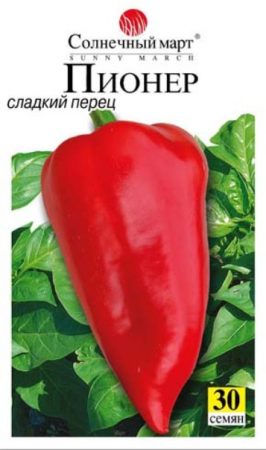
The Ukrainian "comrade" was bred in 1987. Ripens on 120 - 130 days after emergence. Fruits are conical, with light ribbing, sweet, weighing up to 60 g, with a wall thickness of up to 5 mm, red. Productivity per 1 square. m - 1, 5 - 4 kg. Bushes up to 75 cm high. Resistant to pests and diseases.
Winnie the Pooh

Early ripe. Stamp. Determinant type. From the first seedlings to maturity - 120 - 130 days. Bushes are small, leafy up to 30 cm tall. The fruits have the shape of a sharp cone, up to 10 - 12 cm long and weighing about 60 g. Walls 0, 7 cm. Sweet, universal purpose. It is long stored, transportable. Productivity - about 5 - 6 kg per 1 square. m
Firstborn of Siberia
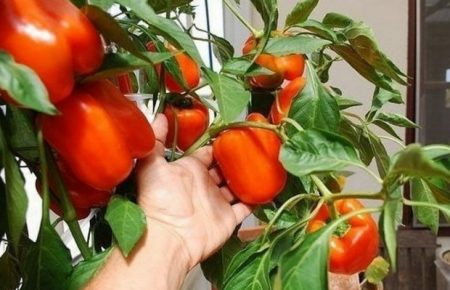
The name itself can speak of its early maturation. The first ripe peppers can be obtained in 100 - 110 days. A bush with a height of not more than 40 - 50 cm, on which there is a simultaneous growth of red and yellow, sweet fruits of a pyramidal shape, up to 10 cm long and weighing 70 g. The walls are 1 cm thick. High-yielding - 10 - 12 kg per 1 sq. m. It is immune to viruses.
Donetsk early
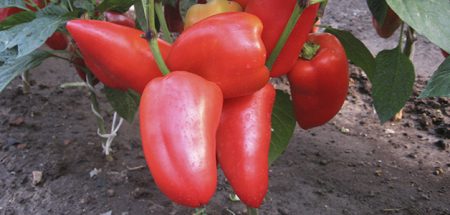
Stunted bush. After 110 - 125 days, active fruiting begins. Fruits have a conical shape with a rounded top. Resistant to temperature fluctuations, viruses and pests. Universal purpose.
Dandy
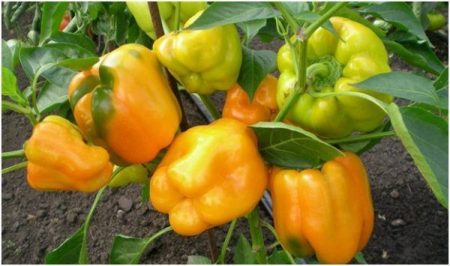
He announced himself relatively recently. Early. The bush is compact up to 50 cm. The fruit has the shape of a barrel, yellow-orange in color, with a wall thickness of up to 0.9 cm, weighing up to 210 g. Universal purpose. Resistant to temperature extremes, diseases and pests.
Triton
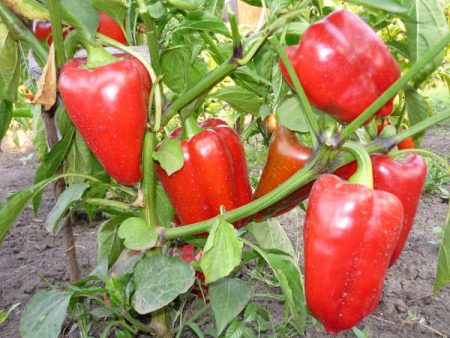
An early harvest can be obtained after 90 days from the first sprouts. A short bush - up to 50 cm, capable of forming more than 50 ovaries. The ripe fruit weighs a cone shape, up to 200 g, with a wall thickness of 5 to 6 mm, has a red color. Good yield with 1 sq. Km. m - 10 - 11 kg. For speed of development, the first entry is recommended to be deleted. Resistant to temperature changes. Universal purpose, but more suitable for processing.
Rules for choosing varieties of pepper
This culture is very widely represented on the market. It is sometimes difficult not to get confused in the whole variety of varieties, their forms, color, purpose and other features. What you need to know to make the right choice?
Hybrid or non hybrid
This criterion is important for those who prefer to choose their own seeds. The “F 1” icon means that this is a first-generation hybrid and you cannot get seeds from it.
They have their advantages: high productivity and resistance to disease. Compared to their non-hybrid "brothers."
Ripening time
Early - 70 - 110 days.
Mid-season - 115 - 135 days.
Late - from 145 days.
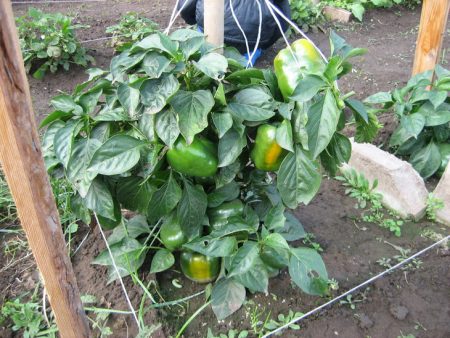
The best option is to plant plants with different dates. Thus, you can enjoy your favorite vegetables for a long time, because most peppers are well stored. In a cold climate, of course, you can’t do without a greenhouse, so the early ones are preferable, the later ones may not have time to ripen.
Size and shape
This criterion is for those who use peppers in the culinary business or for decoration. For example, large, spherical fruits with thick walls are suitable for stuffing or salads.And for decoration, small fruits of an unusual shape are also suitable.
Seedling Care Rules
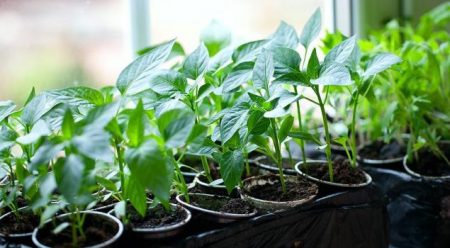
If there is no greenhouse or greenhouse, the seeds are sown in February, so that by May, before transplanting, they have reached development more than 95 days. Peppers do not particularly like picking, so it is better to sow them immediately in small peat pots. For seedlings, a loose substrate with such a calculation is suitable (2 parts of humus + 1 part of sand + 1 part of the earth). For 1 kg of this composition - 1 tbsp. l ash with a slide.
Seeds must first be treated in this way: keep in the water until the swelling in water +45 degrees. And before biting, keep them in a moist gauze cloth for 2 to 3 days in a warm room. After this procedure, you can get the first shoots in the first days after sowing.
Sown seeds after the first warm watering should be covered with a film. Do not shed them during the whole development. It is necessary to monitor the temperature during the day enough + 25 - + 28, and at night from + 11 - + 18. The air should not be dry, without drafts.
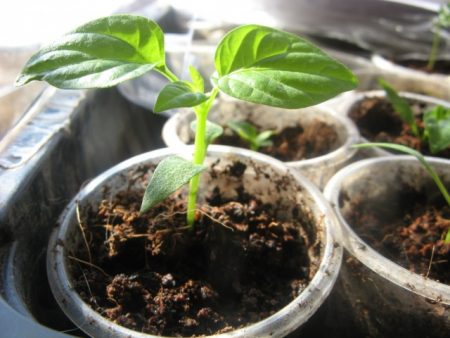
Before planting, seedlings, it will be useful to conduct hardening procedures, taking them to cool places, gradually increasing its length of stay there. The main thing is that it does not fall under freezing.
In the future, it is enough to water, tie and feed in a timely manner. For example, nettle infusion (part of nettle per 10 parts of water, left for 2–3 days) can serve as a good top dressing.
Although peppers are a thermophilic crop, they are grown on the open ground, and not only in greenhouses. And they, like other plants, need care, because proper, good care is the key to good yield and proper development of the plant.
Reviews
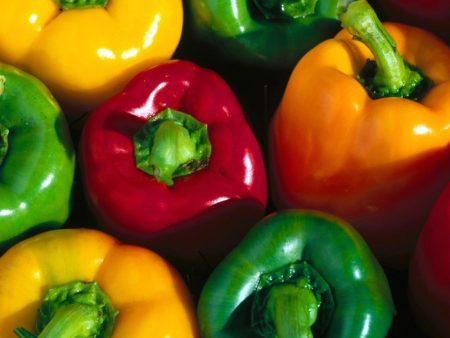
Lyudmila
For 2 years now I have been planting Kolobok, although the summer weather was not at all flighty, it still fruited and did not cause problems with diseases or pest attacks. I plant in a greenhouse and away from each other. I like its thick-walled and small number of seeds. I do not buy seeds, I collect my own, they all sprout. Good taste, I advise. Suitable for anything.
Larisa
I like Montero and Early Miracle. I collect a lot of them, which is enough for sale, for pickling and salads for breakfast. They are unpretentious, which suits me. Planted seedlings in warm soil, without exposing the roots, in high beds for better fruiting. Between the rows I plant corn as a barrier to their pollination. In heat, remove the lower shoots once a week.
Svetlana
I like The Gingerbread Man and Claudio. I mulch with fine straw and because of this I can water them once a week or more. I tie up. For prophylaxis from a bear, I fill the wells with a pinch of ash an hour before planting the seedlings. I collect 10 kg per 1 sq. Km. m. I freeze them for the winter, salt and a small part is eaten by children directly from the garden. I can safely recommend to all summer residents - amateurs!




 Calorie pepper stuffed with meat and rice - BZHU per 100 grams
Calorie pepper stuffed with meat and rice - BZHU per 100 grams Gorky pepper - the best varieties for open ground
Gorky pepper - the best varieties for open ground Hot pepper seeds - the best varieties for open ground and reviews
Hot pepper seeds - the best varieties for open ground and reviews Capsicum tincture for hair - how to use and reviews
Capsicum tincture for hair - how to use and reviews